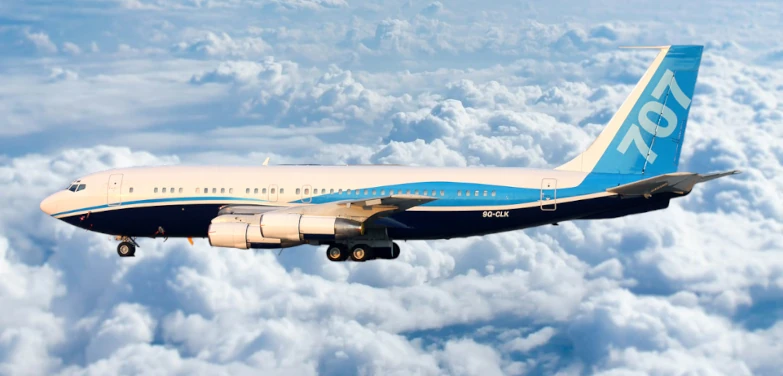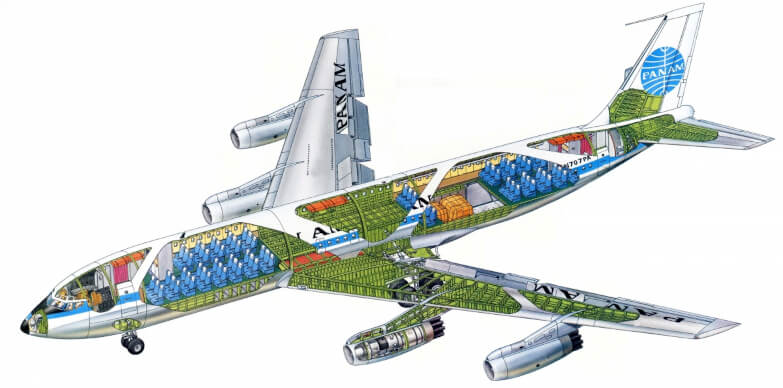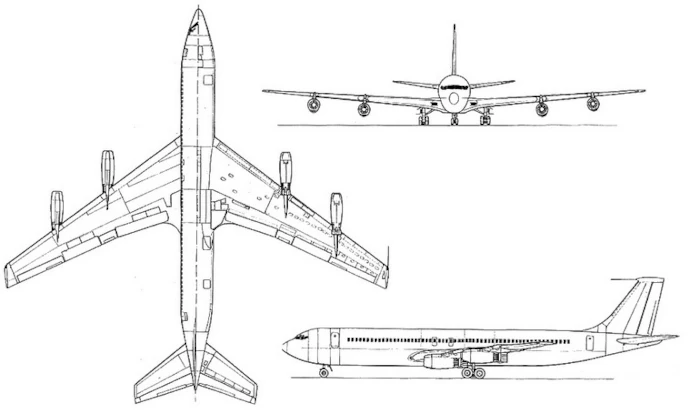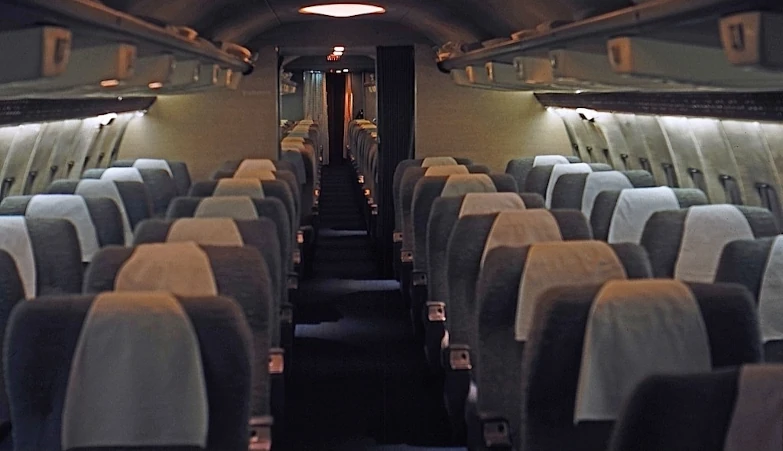
B707 General Overview
Introduction the Boeing 707
The 707, a pioneer of the jet age, stands as a monumental milestone in the annals of aviation. Crafted by Boeing Commercial Airplanes, this aircraft family heralded the dawn of commercial jet travel, reshaping the trajectory of air transportation. Among its array of variants, the 707-120 shone for its prowess in transcontinental flights, while the 707-320 boasted unmatched intercontinental reach. Complementing these giants was the nimble and swift 720, tailor-made for shorter routes demanding higher speeds.
Beyond its civilian guise, the B707 found new purpose in the military realm, incarnating as the E-3 Sentry and the C-137 Stratoliner, showcasing its adaptability and utility. Fueled by Pratt & Whitney JT3C engines, these marvels of engineering transcended mere conveyances, becoming emblems of advancement, seamlessly knitting together distant lands and disparate cultures with unprecedented celerity and efficiency.
The legacy of the Boeing 707 endures, not merely as an imposing figure etched against the azure canvas of the sky, but as a testament to the shrinking of our vast world, drawing humanity ever closer with each journey undertaken.
History of the 707 Boeing
In the 1940s, Boeing specialised mainly in the development of military aircraft. When the Second World War ended and the demand for bombers disappeared, the company began to develop passenger and cargo aircraft. Thus, in 1950, the design of the 707 Boeing airliner began. The B-47 bomber was used as a prototype. Development in those days was carried out in conditions of strict secrecy.
B707 during the development period had the name 367-80.
The B-707, introduced by the Boeing Corporation in 1954, became a milestone in the history of civil aviation as one of the very first mass-produced airliners. Its introduction revolutionised international air travel, making it more affordable and widespread.
From 1958 to 1991, 1,010 aircraft of various configurations and modifications were produced, and Pan American World Airways began commercial operation in 1958. Prior to its introduction, air travel was considered prohibitively expensive and fraught with safety concerns. However, the innovative design elements incorporated in the Boeing 707 transformed civil aviation, democratising air travel on a global scale.

A four-engine turbojet low-wing low-wing jet with a sweeping wing and a single keel, the 707 had several distinctive features. In particular, it was the world’s first passenger aircraft to have engines housed in separate nacelles, with the nacelles themselves suspended under the wing on pylons – an unprecedented design innovation. In addition, the B707 was the first jet aircraft to perform a barrel roll, not once, but twice in a row.
The 707 Boeing quickly took a leading position in the aviation market of its time, creating a high demand that accelerated the development of airport infrastructure. This included the construction of passenger terminals, runway extensions, air traffic control systems, and the organisation of additional services such as baggage handling, in-flight catering and ticketing companies. The Boeing 707 essentially set the stage for the current state of international civil aviation.
Alongside such legendary aircraft as the British DH-106 Comet, the Soviet Tu-104 and the French Sud Aviacion Caravelle, the B707 is recognised as the ‘pioneer’ of global jet aviation and has left behind an indelible legacy. Its history includes ground-breaking achievements such as the creation of the first ever jet passenger aircraft with separate engine nacelles and nacelles suspended under the wing on pylons, highlighting its critical role in setting the course of modern air transport.
The Boeing 707, based on the Boeing 367-80 (Dash-80) prototype, was a major breakthrough in aircraft technology. Powered by Pratt & Whitney JT3C engines, which were modified from the J57 engines of the B-52 bomber, this aircraft had an unusual layout: four engines were located on pylons under a 35-degree sweep wing.
The fuselage underwent a major redesign, receiving an enlarged design with a pointed nose, which housed the radar antenna. With a maximum takeoff weight of 86,184kg, the airliner had various variants, including military versions for carrying fuel or cargo and passenger versions capable of carrying up to 130 passengers.
Facing stiff competition from rivals such as McDonnell Douglas with its DC-8, Boeing engineers embarked on a comprehensive redesign of the original design. As a result, the fuselage was widened to 3.56 metres to accommodate 3+3 seats and increase passenger capacity to 150. Structural improvements included new shaped portholes and chemically milled skin panels, as well as increased internal fuel tank capacity.
The Boeing 707-120 variant was 44.04 m long, while the specialised 707-138 variant was 3.04 m shorter. Engine power was increased through water injection and noise cancellation technologies were introduced to improve passenger comfort.
Pan American became the first customer for the passenger variant, ordering 20 707-112s, indicating the commercial viability of the aircraft. At the same time, Douglas announced a long-range version of the DC-8, prompting a response from Boeing in the form of a long-range 707-320 Intercontinental variant.
Pan American and TWA became the primary operators of the B707, revolutionising the international airline market and significantly increasing the size of their fleets. Notably, Qantas was the first non-US carrier to adopt the Boeing 707, and Western European airlines quickly followed suit, further cementing its status as an aviation icon.

Boeing 707 Versions
The airliner is represented by 7 passenger and cargo-passenger modifications:
Several military modifications of the airliner were also developed on the basis of the Boeing 707, which served the U.S. Air Force:
Boeing 707 Technical Details

Weight
| Model | 707-120B | 707-320B |
| Max. Takeoff Weight (kg) | 116,700 | 151,300 |
| Max. Landing Weight (kg) | 86,200 | 112,000 |
| Empty Weight (kg) | 58,700 | 65,400 |
| Max. Zero Fuel Weight (kg) | 77,100 | 88,500 |
| Max. Payload (kg) | 19,300 | 23,400 |
| Max. Fuel Capacity (kg) | 65,700 | 90,290 |
Dimensions
| Model | 707-120B | 707-320B |
| Length (m) | 44.0 | 46.6 |
| Wingspan (m) | 39.9 | 44.4 |
| Height (m) | 12.7 | 12.7 |
| Wing Area (sq.m) | 226.0 | 268.7 |
Cabin
| Model | 707-120B | 707-320B |
| Number of Seats (Economy) | 174 | 189 |
| Number of Seats (Economy/Business) | 137 | 141 |
| Cabin Length (m) | 31.9 | 33.9 |
| Cabin Width (m) | 3.56 | 3.56 |
| Cabin Height (m) | 2.38 | 2.38 |
Flight Data
| Model | 707-120B | 707-320B |
| Max. Payload Range (km) | 6,700 | 9,200 |
| Max. Cruise Speed (km/h) | 965 | 965 |
| Engines | P&W JT3D-1, 4 x 7,700 kgf |
P&W JT3D-3, 4 x 8,170 kgf P&W JT3D-7, 4 x 8,600 kgf |
Boeing 707 Passenger Cabin
Boeing 707 series airliners have a standard cabin layout with a division into 2 classes: First class and Economy. The standard 320B version has a seating capacity of 151 people. The seats are distributed as follows: First class – 16, Second (or economy) – 135.
Initially, both classes in the aircraft were divided into smoking and non-smoking areas. This created the most comfortable conditions for lovers of this addiction. In business class the smoking zones were in rows 3-4, in second class from 19 to 28. Today there is no such distribution in any international airline due to the anti-tobacco policy, which has spread all over the globe.
In the first class, the cabin layout assumes the distribution of seats on the principle of 2+2, in the second class 3+3. Hence the distance between the seats in business class is much greater. This allows several people to move apart freely.

The Conclusion of the Boeing 707 Era
As the 1960s drew to a close, the Boeing 707 found itself constrained by its own success. Struggling to accommodate the burgeoning passenger traffic on its designated routes, Boeing faced the realization that elongating the fuselage further was neither economically viable nor technically feasible. The prospect of lengthening the fuselage necessitated larger, more potent engines and an increased landing gear span, rendering many airports incompatible with the aircraft.
Boeing initiated the development of the 747, addressing the escalating need for high-capacity aircraft on long-haul routes. As the early 1970s dawned, orders for the Boeing 707 plummeted sharpl. The year 1978 witnessed the complete cessation of serial production, signaling the conclusion of an era. The final scheduled passenger flight of the Boeing 707 to the USA took place in 1983, with Lebanon emerging as one of the last significant operators, sustaining operations until 1998.
At the moment, the Boeing 70 7 is mainly used by military and government organisations rather than commercial airlines.





